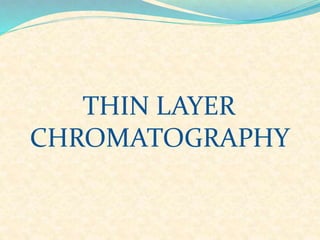
Thin layer chromatography
- 2. CHROMATOGRAPHY: Chromatography is a technique for separating mixtures into their components in order to analyze, identify, purify and/or quantify the mixture or components. The term ”Chromatography” originates from two Greek words Khroma(colour) and graphic (writing) and means colour writing. A Russian botanist Mikhail Tsvet (1906) first developed this technique for differentiation of the substances of the cytosol. Chromatography can be divided in two types Planer and Column TLC is one type of planer chromatography. Chromatography Planer Paper TLC Column
- 3. Thin Layer Chromatography: Definition: Thin layer chromatography, or TLC, is a method for analyzing mixtures by separating the compounds in the mixture. TLC can be used to help determine the number of components in a mixture, the identity of compounds, and the purity of a compound. By observing the appearance of a product or the disappearance of a reactant, it can also be used to monitor the progress of a reaction. TLC is a sensitive technique - microgram (0.000001 g) quantities can be analyzed by TLC- and it takes little time for an analysis (about 5-10 minutes) TLC is performed using thin sheets of glass, aluminum or plastic coated with a layer of stationary phase, usually silica gel. However, other coatings such as alumina, polyamide, cellulose, ion exchangers, and chemically bonded amino or phenol layers can also be used. Using polar group like Silica provide chance of separation of polar and non-polar material by using non-polar solvent. Readymade TLC sheets are commercially available but mobile phase is chosen according to the Type of sample being used. . Molecular structure of silica gel (SiO2.xH2O)n
- 4. TLC consists of three steps – 1)spotting, 2)development and 3)visualization. Spotting: In TLC, the sample must be carefully applied to the plate to minimize spreading. Sample sizes from 0.1 mg to 50 mg are the best for TLC. Smaller amounts are difficult to visualize, while larger spots result in overloading and variable results. Samples should be dissolved in relatively volatile solvents (0.5 to 5mL) so that the spots do not spread excessively(3-4 mm diameter). Application of sample
- 5. Development: The spotted plate is placed in a sealed development tank filled with vapor of mobile phase its lower side immersed in solvent to a level below the applied sample spots. The solvent rises due to capillary flow in a process called development. Development times can range from 3-60 minutes. Basic model of TLC chromatography chamber Then the TLC plate is dried by drier.
- 6. Visualization: 1) Visible - the bands or spots can be seen immediately. 2) Fluorescence - observed under UV light. 3) Absorb UV - plate has an indicator that when irradiated will show analytes as dark spots on a bright background. 4) Reaction with a chromogenic reagent - These reagents may be general (reacting with many different compounds) or selected (reacting only with certain functional groups. 5) Organic Materials - treat plates with concentrated sulfuric acid and then heat at 200oC. Analytes show up as dark spots. 6)The plate is sprayed with ninhydrin and heated at hot air oven that produce colour of specimen. Visualization by UV light
- 7. The sample components are separated based no there partition coefficient(kd): Cs Kd=----- Cs=concentration of sample in stationary phase Cm Cm=concentration of sample in mobile phase As it can’t be measured directly it is measured by another function Rf Rf= Distance moved by solute from the site of origin spot/Distance moved by solvent But in paper chromatography actual Rf can’t be measured as gravity plays an Important role and relative Rf is measured based on the Rf value of a standard reference.
- 8. A B Rf of A=7.5/10=.75 Rf of B=2.5/10=.25 Relative Rf of A on B =7.5/2.5=3 Calculation of Rf values of the model paper chromatography result
- 9. Advantages of TLC: • The Thin layer chromatography advantages include: • It is simple process with short development time. • It helps in visualization of separated compound spots easily. • The method helps to identify the individual compounds. • It helps in isolation of most of the compounds. • The separation process is faster and the selectivity for compounds is higher even small differences in chemistry is enough for clear separation. • The purity standards of the given sample can be assessed easily. • It is a cheaper chromatographic technique.
- 10. Applications of Thin layer chromatography 1. To check purity of given samples. 2. Identification of compounds like acids, alcohols, proteins, alkaloids, amines, antibiotics etc. 3. To evaluate reaction process by assessment of intermediates, reaction course etc. 4. To purify samples i.e. for purification process. 5. To keep a check on the performance of other separation processes.
